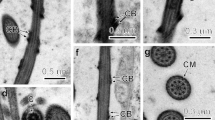Summary
-
1)
The original polarity of the sea-urchin egg is due
-
α)
to the elongation of the growing oocyte at right angles to the wall of the ovarian follicle,
-
β)
to the position of the nucleus near the free end,
-
γ)
to the formation of the micropyle at the free end,
-
δ)
to the breaking down of the nucleus, prior to maturation, near the free end and to the consequent liberation at this end of a mass of granular material of nuclear origin.
-
2)
The nucleus makes, during the growth period, the following contributions to the structure of the cytoplasm:
-
α)
small solid chromatic granules,
-
β)
nuclear material (chromatic) appears to diffuse out into the cytoplasm. From this moment the nucleus is oxyphile (except for the chromosomes which appear at maturation) while the cytoplasm is basophil,
-
γ)
the granular contents of the nucleus on the rupture of the membrane at the time of maturation.
The third, if not the first two, contribution is of great importance in determining the polar structure of the egg, and hence of the embryo, that is, in the eventual production of inherited resemblance.
-
3)
A bilateral symmetry can be detected even in the mesenchyme blastula stage. Since this depends partly on a slight excess of basophil material on one side it may have been originally caused by the entrance of the spermatozoon.
Zusammenfassung
-
1)
Die ursprüngliche Polarität des Seeigeleies ist bedingt:
-
a)
durch die Verlängerung der wachsenden Eizelle rechtwinklig zur Wand des Eierstocksfollikels,
-
b)
durch die Lage des Kerns nahe der freien Oberfläche,
-
c)
durch die Bildung der Mikropyle an der freien Oberfläche,
-
d)
durch die den Reifungsvorgängen vorhergehende Auflösung des Kerns in der Nähe der freien Oberfläche und das hierdurch veranlaßte, vom Kern herstammende Freiwerden einer Menge granulierten Materials an dieser Oberfläche.
-
2)
Der Kern liefert im Verlauf der Wachstumsperiode folgende Beiträge zum Aufbau des Cytoplasmas:
-
a)
kleine solide chromatische Körnchen,
-
b)
Kernmaterial (chromatisches) scheint in das Cytoplasma auszudiffandieren. Von diesem Zeitpunkt an ist der Kern oxyphil (ausgenommen die bei den Reifungserscheinungen auftretenden Chromosomen), während das Cytoplasma basophil ist,
-
c)
den körnigen Inhalt des Kerns beim Zerreißen der Membran zur Zeit der Eireifung;
-
d)
der dritte Beitrag — wenn nicht auch die ersten beiden — ist von großer Bedeutung für die Determination der polaren Eistruktur, und von jetzt an auch für die des Embryo, nämlich bei der eventuellen Herstellung vererbter Ähnlichkeit.
-
3)
Bilaterale Symmetrie kann man sogar im Stadium der Mesenchymblastula finden. Da dies teilweise von einem leichten Exzeß basophilen Materials auf einer Seite abhängt, so kann es ursprünglich durch den Eintritt des Spermatozoons veranlaßt sein.
Similar content being viewed by others
References
T.Boveri, Über die Polarität des Seeigeleies. Verh. phys.-med. Ges. Würzburg. 34. 1900.
- Die Polarität von Ovocyte, Ei und Larve des Strongylocentrotus lividus. Zool. Jahrb. (Anat.) 14. 1901.
- Zellen-Studien. V. Jena 1905.
T. H.Bryce, Maturation of the ovum in Echinus esculentus. Quart. Journ. Micr. Sci. 46. 1903.
G.Chubb, On the growth of the oocyte in Antedon. Phil. Trans. 198 B. 1906.
E. G.Conklin, The organization and cell-lineage of the Ascidian egg. Journ. Acad. Nat. Sci. Philadelphia. 13. 1905.
H.Driesch, Entwicklungsmechanische Studien. I. Zeitschr. wiss. Zool. 53. 1892.
- Betrachtungen über die Organisation des Eies und ihre Genese. Arch. Entw.-Mech. 4. 1897.
- Die isolierten Blastomeren des Echinidenkeimes. Arch. Entw.-Mech. 10. 1910.
- Studien zur Entwicklungsphysiologie der Bilateralität. Arch. Entw.-Mech. 21. 1906.
T.Garbowski, Über die Polarität des Seeigeleies. Bull. Internat. Acad. Sc. Cracovie. 1905.
E.Godlewski, Untersuchungen über die Bastardierung der Echiniden- und Crinoidenfamilie. Arch. Entw -Mech. 20. 1906.
E.Korschelt und K.Heider, Lehrbuch der vergleichenden Entwicklungsgeschichte der wirbellosen Tiere. Allgem. Teil. 1. Lief. Kap. IV. Jena 1902.
H.Kupelwieser, Entwicklungserregung bei Seeigeleiern durch Molluskensamen. Arch. Entw.-Mech. 27. 1909.
J.Loeb, Über die Befruchtung von Seeigeleiern durch Seesternsamen.Pflügers Arch. 99. 1903.
- Über die Natur der Bastardlarve zwischen dem Echinodermenei und Molluskensamen. Arch. Entw.-Mech. 26. 1908.
E. P.Lyon, Results of centrifuging eggs. Arch. Entw.-Mech. 23. 1907.
T. H.Morgan and G. B.Spooner, The polarity of the centrifuged egg. Arch. Entw.-Mech. 28. 1909.
H. H.Newman, The process of heredity as exhibited by the development of Fundulus hybrids. Journ. Exp. Zool. 5. 1907 and 8. 1910.
H.Schmidt, Zur Kenntnis der Larvenentwicklung von Echinus microtuberculatus. Verh. phys.-med. Ges. Würzburg. 36. 1904.
E.Selenka, Die Keimblätter der Echinodermen. Wiesbaden 1883.
E. B.Wilson, The Cell. New York 1902.
- Atlas of Fertilization. New York 1895.
E. B.Wilson and A. P.Mathews, Maturation, Fertilization and Polarity in the Echinoderm egg. Journ. Morph. 10. 1895.
Author information
Authors and Affiliations
Rights and permissions
About this article
Cite this article
Jenkinson, J.W. On the origin of the polar and bilateral structure of the egg of the Sea-urchin. Archiv für Entwicklungsmechanik der Organismen 32, 699–716 (1911). https://doi.org/10.1007/BF02161913
Received:
Issue Date:
DOI: https://doi.org/10.1007/BF02161913




